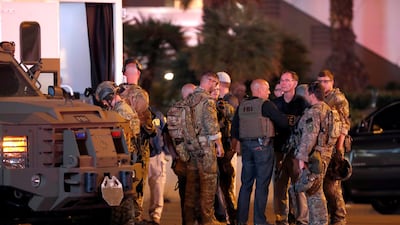More than 50 people were killed and more than 400 injured when a gunman shot towards an outdoor music festival on the Las Vegas Strip in the worst mass shooting in US history.
The suspect, who was killed by police, was identified as 64-year-old Stephen Paddock. He was confronted by the police on the 32nd floor of the Mandalay Bay Resort and Casino across the street from the concert.
The previous deadliest mass shooting was an attack at an Orlando, Florida nightclub that killed 49 people.
Here’s a list of the deadliest rampages in the US since 2012:
October 1, 2017 — Paddock killed at least 50 people and wounded more than 400 at music festival in Las Vegas, Nevada.
June 12, 2016 — Gunman Omar Mateen opened fire at a nightclub in Orlando, killing 49 people. He was later killed in a shoot-out with police.
February 25, 2016 — Cedric Ford, 38, killed three people and wounded 14 others at a lawnmower factory where he worked in the central Kansas community of Hesston. He was killed in a shoot-out with police.
February 20, 2016 — Jason Dalton, 45, is accused of randomly shooting and killing six people and wounding two others during a series of attacks over several hours in the Kalamazoo, Michigan area. He faces murder and attempted murder charges.
December 2, 2015 — Syed Rizwan Farook, 28, and Tashfeen Malik, 27, opened fire at a social services centre in San Bernardino, California, killing 14 people and wounding more than 20. They in a shoot-out with police.
October 1, 2015 — A shooting at Umpqua Community College in Roseburg, Oregon, left 10 people dead and seven wounded. Shooter Christopher Harper-Mercer, 26, exchanged gunfire with police, then killed himself.
June 17, 2015 — Dylann Roof, 21, shot and killed nine African-American church members during a Bible study group inside the Emanuel African Methodist Episcopal Church in Charleston, South Carolina. Roof has been sentenced to death in the shootings.
May 23, 2014 — A community college student, Elliot Rodger, 22, killed six people and wounded 13 in shooting and stabbing attacks in the area near the University of California, Santa Barbara, campus. Authorities said he shot himself to death after a gun battle with deputies.
September 16, 2013 — Aaron Alexis, a mentally disturbed civilian contractor, shot 12 people to death at the Washington Navy Yard before he was killed in a police shoot-out.
July 26, 2013 — Pedro Vargas, 42, went on a shooting rampage at his Hialeah, Florida, apartment building, gunning down six people before officers fatally shot him.
December 14, 2012 — In Newtown, Connecticut, an armed 20-year-old man entered Sandy Hook Elementary School and used a semi-automatic rifle to kill 26 people, including 20 first graders and six adult school staff members. He then killed himself.
September 27, 2012 — In Minnesota's deadliest workplace rampage, Andrew Engeldinger, who had just been fired, pulled a gun and fatally shot six people, including the company's founder. He also wounded two others at Accent Signage Systems in Minneapolis before taking his own life.
August 5, 2012 — In Oak Creek, Wisconsin, 40-year-old gunman Wade Michael Page killed six worshippers at a Sikh Temple before killing himself.
July 20, 2012 — James Holmes, 27, fatally shot 12 people and injured 70 in an Aurora, Colorado, movie theatre. He was sentenced to life in prison without parole.
April 2, 2012 — Seven people were killed and three were wounded when a 43-year-old former student opened fire at Oikos University in Oakland, California. One Goh was charged with seven counts of murder and three counts of attempted murder, but psychiatric evaluations concluded he suffered from long-term paranoid schizophrenia and was unfit to stand trial.

